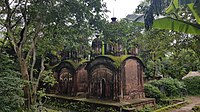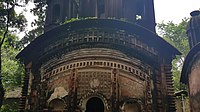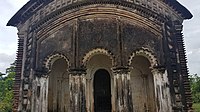Ghatal is a city and a municipality in Paschim Medinipur district, West Bengal, India. It is the headquarters of the Ghatal subdivision.

Chandrakona is a town and a municipality in the Ghatal subdivision of Paschim Medinipur district in the state of West Bengal, India. The city is located between Ghatal and Garhbeta. The king – Chandraketu was the founder of the kingdom of Chandrakona. In Ain-E-Akbari it was mentioned as ‘Mana’.

Khirpai, also known as Kshirpai, is a city and a municipality in the Ghatal subdivision of the Paschim Medinipur district in the state of West Bengal, India. The city is situated between Ghatal and Chandrakona, near the banks of the rivers Shilabati and Kethai, and is one of the oldest municipalities in India. Khirpai is also famous for its ‘Babarsha’, a special type of sweetmeat, which is not available elsewhere.

Ramjibanpur is a city and a municipality in the Ghatal subdivision of the Paschim Medinipur district in the Indian state of West Bengal.
Daspur I is a community development block that forms an administrative division in Ghatal subdivision of Paschim Medinipur district in the Indian state of West Bengal.

Kharar is a historical town and one of the oldest municipality in Asia. This city is located in the Ghatal Subdivision of the Indian state of West Bengal.
Ghatal is a community development block that forms an administrative division in Ghatal subdivision of Paschim Medinipur district in the Indian state of West Bengal.
Patrasayer is a village in the Patrasayer CD block in the Bishnupur subdivision of the Bankura district in the state of West Bengal, India.

Narajole is a village and gram panchayat in Daspur I CD Block in Ghatal subdivision of Paschim Medinipur district in the state of West Bengal, India.
Paikbheri is a village in the Bhagabanpur I CD block in the Egra subdivision of the Purba Medinipur district in the state of West Bengal, India.
Shantinatha Shiva Temple is a nava-ratna temple, built in 1828 at Mitrasenpur, Chandrakona in Ghatal subdivision of Paschim Medinipur district in West Bengal, India.
Malleswara Shiva Temple is a pancha-ratna temple, built in the 18th century at Chandrakona in Ghatal subdivision of Paschim Medinipur district in West Bengal, India.
Dihi Baliharpur is a village in the Daspur I CD block in the Ghatal subdivision of the Paschim Medinipur district in the state of West Bengal, India.
Gobindanagar is a village in the Daspur I CD block in the Ghatal subdivision of the Paschim Medinipur district in the state of West Bengal, India.
Jalsara (জলসরা) is a village in the Ghatal CD block in the Ghatal subdivision of the Paschim Medinipur district in the state of West Bengal, India.
Radhanagar is a village in the Ghatal CD block in the Ghatal subdivision of the Paschim Medinipur district in the state of West Bengal, India.

Bengal temple architecture is about temple styles developed and used in Bengal, particularly the chala, ratna and dalan temples.
Jayantipur is a village in the Chandrakona II CD block in the Ghatal subdivision of the Paschim Medinipur district in the state of West Bengal, India.
Jalchak is a village in the Pingla CD block in the Kharagpur subdivision of the Paschim Medinipur district in the state of West Bengal, India.
Bali Dewanganj is a village and a gram panchayat in the Goghat I CD block in the Arambagh subdivision of Hooghly district in the Indian state of West Bengal.















